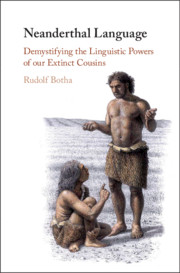Book contents
- Neanderthal Language
- Neanderthal Language
- Copyright page
- Contents
- Figures
- Images
- Acknowledgements
- Copyright Permission for Images
- Part I Preliminaries
- 1 Pursuing an Intriguing but Murky Matter
- 2 Telltale Neanderthal Teeth
- Part II Symbolic Behaviours
- Part III Non-symbolic Behaviours
- Part IV Implications
- Notes
- References
- Index
1 - Pursuing an Intriguing but Murky Matter
from Part I - Preliminaries
Published online by Cambridge University Press: 26 April 2020
- Neanderthal Language
- Neanderthal Language
- Copyright page
- Contents
- Figures
- Images
- Acknowledgements
- Copyright Permission for Images
- Part I Preliminaries
- 1 Pursuing an Intriguing but Murky Matter
- 2 Telltale Neanderthal Teeth
- Part II Symbolic Behaviours
- Part III Non-symbolic Behaviours
- Part IV Implications
- Notes
- References
- Index
Summary
Chapter 1 sets out the concerns, aim, approach and focus of the book, and lists some of its major findings. Its guiding concern is with the lack of uncontroversial answers to questions about the existence and nature of Neanderthal language. Its maim aim is to disperse the murk veiling this phenomenon. For pursuing this aim, the book adopts The Windows Approach to language evolution. In terms of this approach, for claims about Neanderthal language to be credible, they must be conclusions of sound inferences about it. The book, accordingly, unpacks a range of important inferences about Neanderthal language and appraises their soundness. These inferences are drawn from four allegdly symbolic and three non-symbolic behaviours. The book restricts its focus further to inferences about language as a cognitive capacity as distinct from speech as a form of behaviour that presupposes language. To guage the heuristic potential of Neanderthal behaviours as windows on Neanderthal language, the book apparaises in addition the soundeness of important inferences drawn about Neanderthal language from two biological attributes of Neanderthals: the FOXP2 gene and the Broca’s area of the brain.
- Type
- Chapter
- Information
- Neanderthal LanguageDemystifying the Linguistic Powers of our Extinct Cousins, pp. 3 - 10Publisher: Cambridge University PressPrint publication year: 2020

